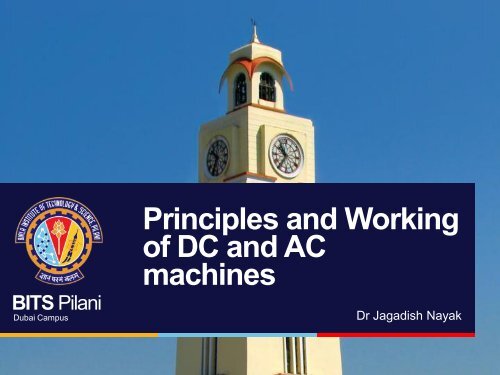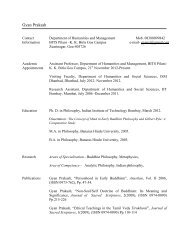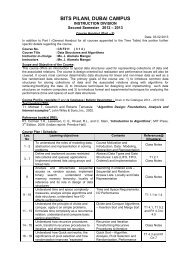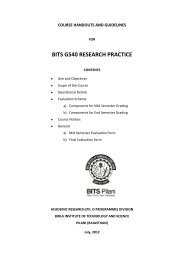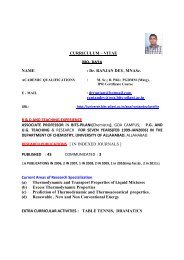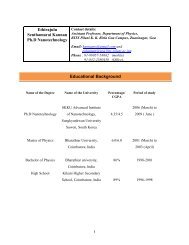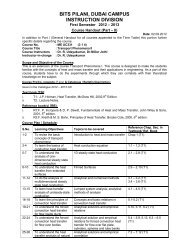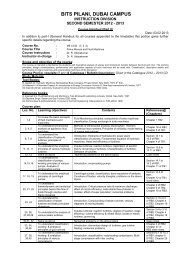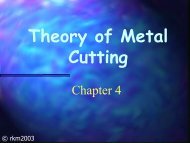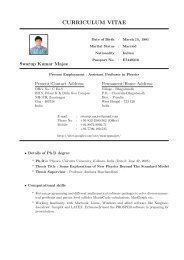Principles and Working of DC and AC machines - BITS Pilani
Principles and Working of DC and AC machines - BITS Pilani
Principles and Working of DC and AC machines - BITS Pilani
Create successful ePaper yourself
Turn your PDF publications into a flip-book with our unique Google optimized e-Paper software.
<strong>BITS</strong> <strong>Pilani</strong><br />
Dubai Campus<br />
<strong>Principles</strong> <strong>and</strong> <strong>Working</strong><br />
<strong>of</strong> <strong>DC</strong> <strong>and</strong> <strong>AC</strong><br />
<strong>machines</strong><br />
Dr Jagadish Nayak
Constructional features<br />
<strong>BITS</strong> <strong>Pilani</strong><br />
Dubai Campus
<strong>DC</strong> Machines<br />
<strong>DC</strong> Generator<br />
<strong>BITS</strong> <strong>Pilani</strong>, Dubai Campus
<strong>DC</strong> Machines<br />
A generator consists <strong>of</strong> a stationary portion called the<br />
stator <strong>and</strong> the rotating portion called the rotor.<br />
A magnetic field is produced when a direct current is<br />
applied to windings <strong>of</strong> the coil in the stator. These coils<br />
are called field windings.<br />
The rotor contains the commutator <strong>and</strong> the conductors<br />
across which emf is induced. This part is called<br />
armature.<br />
<strong>BITS</strong> <strong>Pilani</strong>, Dubai Campus
<strong>DC</strong> Machines<br />
The stator has two poles one labeled N <strong>and</strong> the other S.<br />
The field windings are situated on the poles.<br />
The rotor consists <strong>of</strong> an iron core that has slots which<br />
house the armature conductors <strong>and</strong> a commutator <strong>and</strong><br />
the brushes.<br />
The figure shows the connections <strong>of</strong> the coils to the<br />
commutator<br />
<strong>BITS</strong> <strong>Pilani</strong>, Dubai Campus
<strong>DC</strong> Machines<br />
A uniform magnetic field is produced in the small air<br />
gaps between the poles <strong>and</strong> the rotor when current is<br />
passed through the field windings. This induces an emf<br />
across the coil <strong>and</strong> looks like as shown below.<br />
When the armature windings are connected to the<br />
commutator according to the connections shown earlier ,<br />
the individual emf gets rectified <strong>and</strong> all <strong>of</strong> them add up<br />
together.<br />
<strong>BITS</strong> <strong>Pilani</strong>, Dubai Campus
<strong>DC</strong> Machines<br />
The net effect <strong>of</strong> the coil connections to the commutator<br />
shows a brush voltage which appears as below<br />
<strong>BITS</strong> <strong>Pilani</strong>, Dubai Campus
<strong>DC</strong> Machines<br />
Generated voltage:<br />
The generated voltage is given by:<br />
N n<br />
v g<br />
p a 60<br />
Where N Number <strong>of</strong> armatureconductors<br />
a Number <strong>of</strong> parallel paths between the brushes<br />
p Number <strong>of</strong> poles<br />
Magnetic flux per pole<br />
n speed <strong>of</strong> the rotor in rpm<br />
<strong>BITS</strong> <strong>Pilani</strong>, Dubai Campus
<strong>DC</strong> Machines<br />
<strong>BITS</strong> <strong>Pilani</strong>, Dubai Campus
<strong>DC</strong> Machines<br />
Generator with a load:<br />
The generated emf v g is the voltage across the<br />
armature terminals ( the brushes) when no load is<br />
connected to those terminals.<br />
If there is some electrical load connected to the<br />
armature, the resulting load voltage will be different<br />
from the no load voltage. Now it will depend on the<br />
resistance R a associated with the armature due to<br />
resitance <strong>of</strong> the windings <strong>and</strong> the brush contacts.<br />
<strong>BITS</strong> <strong>Pilani</strong>, Dubai Campus
<strong>DC</strong> Machines<br />
Example :<br />
‣ An 8kW, 200-V dc generator has a full load current <strong>of</strong><br />
40nA at 1200rpm. Given the armature resistance is<br />
Ra=0.5Ω, armature is modeled as shown below, where<br />
RL is a resistive load. Determine the full load voltage for<br />
this generator at 900 rpm.<br />
<strong>BITS</strong> <strong>Pilani</strong>, Dubai Campus
<strong>DC</strong> Machines<br />
If the flux per pole φ is kept constant , then the<br />
generated voltage is directly proportional to<br />
armature speed n.Thus if the field current is kept<br />
constant <strong>and</strong> the flux per pole is kept constant then<br />
at 900 rpm the no load voltage is<br />
<strong>BITS</strong> <strong>Pilani</strong>, Dubai Campus
<strong>DC</strong> Machines<br />
Therefore under full load condition <strong>of</strong> 40 A at 900rpm<br />
the full load voltage is, by KVL<br />
<strong>BITS</strong> <strong>Pilani</strong>, Dubai Campus
<strong>DC</strong> Machines<br />
Generator symbol:<br />
i f is the field current <strong>and</strong> i a denotes the armature<br />
current.<br />
<strong>BITS</strong> <strong>Pilani</strong>, Dubai Campus
<strong>DC</strong> Machines<br />
The rotor <strong>of</strong> a dc generator turning at n rpm induces<br />
an emf ( no load armature voltage) <strong>of</strong><br />
v K n<br />
g<br />
• Where K = Np/60a is a constant determined by the<br />
construction <strong>of</strong> the generator.<br />
<strong>BITS</strong> <strong>Pilani</strong>, Dubai Campus
<strong>DC</strong> Machines<br />
The plot <strong>of</strong> no- load voltage v g vs the field current i f looks<br />
like:<br />
These curves are called magnetization curves <strong>of</strong> the<br />
generator.<br />
<strong>BITS</strong> <strong>Pilani</strong>, Dubai Campus
<strong>DC</strong> Machines<br />
Generator field excitation:<br />
FIELD EXCITATION<br />
When a dc voltage is applied to the field windings <strong>of</strong> a<br />
dc generator, current flows through the windings<br />
<strong>and</strong> sets up a - - steady magnetic field. This is called<br />
FIELD EXCITATION.<br />
This excitation voltage can be produced by the<br />
generator itself or it can be supplied by an outside<br />
source, such as a battery.<br />
<strong>BITS</strong> <strong>Pilani</strong>, Dubai Campus
<strong>DC</strong> Machines<br />
If it is supplied by an outside source then it is called<br />
separately excited generator as shown below.<br />
A generator that supplies its own field excitation is<br />
called a SELF-EXCITED GENERATOR.<br />
<strong>BITS</strong> <strong>Pilani</strong>, Dubai Campus
<strong>DC</strong> Machines<br />
CLASSIFICATION OF GENERATORS<br />
Self-excited generators are classed according to the<br />
type <strong>of</strong> field connection they use.<br />
There are three general types <strong>of</strong> field connections -<br />
SERIES-WOUND, SHUNT-WOUND (parallel), <strong>and</strong><br />
COMPOUND-WOUND.<br />
Compound-wound generators are further classified<br />
as cumulative-compound <strong>and</strong> differential-compound.<br />
<strong>BITS</strong> <strong>Pilani</strong>, Dubai Campus
<strong>DC</strong> Machines<br />
Series-Wound Generator or Series connected<br />
generator<br />
In the series-wound generator, the field windings are<br />
connected in series with the armature.<br />
Current that flows in the armature flows through the<br />
external circuit <strong>and</strong> through the field windings.<br />
The external circuit connected to the generator is<br />
called the load circuit.<br />
<strong>BITS</strong> <strong>Pilani</strong>, Dubai Campus
<strong>DC</strong> Machines<br />
Series Connected generators<br />
The field current is equal to the armature current,<br />
the field winding has very few turns <strong>and</strong> relatively<br />
low resistance.<br />
<strong>BITS</strong> <strong>Pilani</strong>, Dubai Campus
<strong>DC</strong> Machines<br />
Shunt-Wound Generators<br />
In a shunt-wound generator, the field coils consist <strong>of</strong><br />
many turns <strong>of</strong> small wire <strong>and</strong> relatively high field<br />
resistance.<br />
They are connected in parallel with the load. In other<br />
words, they are connected across the output voltage<br />
<strong>of</strong> the armature.<br />
<strong>BITS</strong> <strong>Pilani</strong>, Dubai Campus
<strong>DC</strong> Machines<br />
Shunt Connected generators<br />
<strong>BITS</strong> <strong>Pilani</strong>, Dubai Campus
<strong>DC</strong> Machines<br />
Compound-Wound Generators<br />
Compound-wound generators have a series-field<br />
winding in addition to a shunt-field winding.<br />
The shunt <strong>and</strong> series windings are wound on the same<br />
pole pieces.<br />
<strong>BITS</strong> <strong>Pilani</strong>, Dubai Campus
<strong>DC</strong> Machines<br />
GENERATOR BUILD UP:<br />
-For for a separately excited generator turning at n<br />
rpm, the value <strong>of</strong> the field current determines the<br />
value <strong>of</strong> generated voltage <strong>and</strong> the following<br />
magnetization curve can be used to find it.<br />
<strong>BITS</strong> <strong>Pilani</strong>, Dubai Campus
<strong>DC</strong> Machines<br />
Consider a shunt connected generator where a<br />
rheostat <strong>and</strong> switch is included in the circuit..<br />
When the switch is open ie when i f =0 there will be a<br />
small generated emf due to residual magnetism .<br />
When the switch is closed, there will be a voltage<br />
applied across the series combination <strong>of</strong> field<br />
winding <strong>and</strong> the control rheostat.<br />
This will produce a nonzero field current <strong>and</strong> hence<br />
increases the flux, thereby resulting in an increase in<br />
the generated emf.<br />
<strong>BITS</strong> <strong>Pilani</strong>, Dubai Campus
<strong>DC</strong> Machines<br />
This repetitive process <strong>of</strong> increasing generated voltage<br />
<strong>and</strong> field current is known as generator build up.<br />
The intersection point on the graph shown before<br />
shows generator build up has ceased.<br />
<strong>BITS</strong> <strong>Pilani</strong>, Dubai Campus
<strong>DC</strong> MOTORS:<br />
Rotating Machines<br />
<strong>BITS</strong> <strong>Pilani</strong>, Dubai Campus
<strong>DC</strong> MOTORS:<br />
Consider a conducting loop through which i is the current<br />
flowing.<br />
The slip rings <strong>and</strong> brushes are also present though not<br />
shown here.<br />
The end view <strong>of</strong> the loop is shown in the figure b, where the<br />
current in the upper conductor is directed into the page<br />
(shown by cross X) <strong>and</strong> the current in the lower<br />
conductor is directed out <strong>of</strong> the page.(shown by dot.)<br />
By the Right h<strong>and</strong> rule or by using unit vectors the force on<br />
the upper conductor is<br />
F= Bil in the downward direction.<br />
<strong>BITS</strong> <strong>Pilani</strong>, Dubai Campus
<strong>DC</strong> MOTORS:<br />
Similrly on the lower conductor the force <strong>of</strong> same<br />
magnitude acts in the upward direction.<br />
Since the line <strong>of</strong> action <strong>of</strong> the two forces is not the same, a<br />
torque is developed which is<br />
Fd= Blirsinδ, where δ is the angle formed by the y-z<br />
plane <strong>and</strong> the plane <strong>of</strong> the loop <strong>and</strong> is called the torque<br />
angle or power angle.<br />
For N turns in a coil <strong>and</strong> 2 conductors the torque becomes<br />
T = 2NBlir sinδ = NBAisinδ, where A = 2rlis the area <strong>of</strong><br />
the coil.<br />
<strong>BITS</strong> <strong>Pilani</strong>, Dubai Campus
<strong>DC</strong> MOTORS:<br />
The torque is max when δ= 90deg when sinδ=1<br />
This torque tends to rotate the loop in the clockwise<br />
direction.<br />
Due to the loop rotating clockwise , the emf is induced<br />
which tends to produce a current in the direction<br />
opposite to the applied current.<br />
This is the principle on which the dc motor works.<br />
<strong>BITS</strong> <strong>Pilani</strong>, Dubai Campus
<strong>DC</strong> MOTORS:<br />
Armature model for the dc motor:<br />
<strong>BITS</strong> <strong>Pilani</strong>, Dubai Campus
<strong>DC</strong> MOTORS:<br />
The figure shows the armature portion <strong>of</strong> the motor.<br />
R a is the armature resistance v L is the applied or the line<br />
voltage <strong>of</strong> the motor.<br />
WKT v g = Kφn, where K is a constant, φ is the flux per<br />
pole <strong>and</strong> n is the rptor (armature) speed.<br />
For a dc motor, from the circuit by KVL we have<br />
V L =R a i a + v g<br />
And since v g = Kφn then<br />
V L = R a i a + Kφn<br />
Hence speed ( in rpm ) <strong>of</strong> the motor is<br />
This is known as the speed equation <strong>of</strong> a<br />
dc motor.<br />
<strong>BITS</strong> <strong>Pilani</strong>, Dubai Campus
<strong>DC</strong> MOTORS:<br />
The torque developed by the dc motor is determined by the<br />
armature current <strong>and</strong> the magnetic flux density <strong>and</strong><br />
hence the field flux (flux per pole).<br />
Therefore Torque can be written as<br />
<strong>BITS</strong> <strong>Pilani</strong>, Dubai Campus
<strong>DC</strong> MOTORS:<br />
A 220 volt dc shunt motor has a speed <strong>of</strong> 1200 rpm <strong>and</strong> an<br />
armature current <strong>of</strong> 6A at no load. Given that the<br />
armature resistance is 0.5 Ω, determine the motor speed<br />
when the armature current is 40A at full load.<br />
<strong>BITS</strong> <strong>Pilani</strong>, Dubai Campus
<strong>DC</strong> MOTORS:<br />
The motor speed at full load written as n FL differs from the<br />
speed at no load n NL .<br />
A measure <strong>of</strong> change in speed is the speed regulation <strong>of</strong><br />
the motor, which is defined as<br />
Therefore<br />
<strong>BITS</strong> <strong>Pilani</strong>, Dubai Campus


